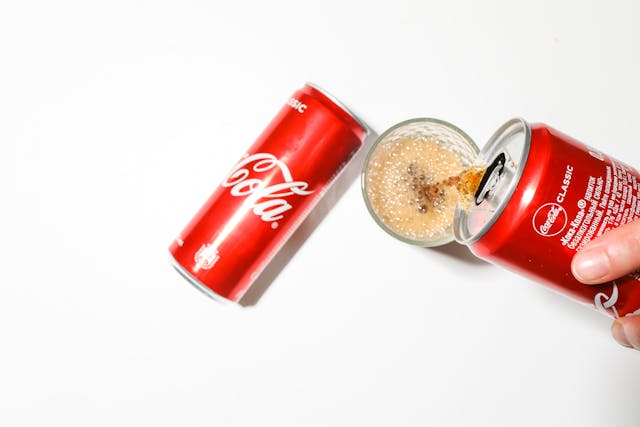
What is the fizz in fizzy drinks? The fizz in fizzy drinks comes from carbon dioxide, which is why the process is called carbonation, and they are called carbonated beverages.
A lot of drinks have a natural fizz. Beer has fizz and bubbles because it is made with yeast. The yeast eats sugar and releases alcohol and carbon dioxide in the process. The same thing happens with bread, except the bubbles are baked in, giving the bread its fluffy texture. In fizzy drinks, carbon dioxide has to be added.
When you make a fizzy drink, such as Coca-Cola, you need to add enough carbon dioxide to give it the required fizz. That is not easy to do because carbon dioxide doesn’t dissolve into water very easily. A lot of gases will dissolve into water very readily, but carbon dioxide isn’t one of them. Water molecules and carbon dioxide molecules can bond, but water is a polar molecule, while carbon dioxide is nonpolar. Polar means that the molecule has a positive and a negative end. Nonpolar means both ends are either positive or negative. Water is polar because the oxygen molecule is larger than the hydrogen molecules, so it attracts more of the electrons. Carbon dioxide is nonpolar. Polar molecules attract more easily to other polar molecules, which is why water is strong. They don’t attract very well to nonpolar molecules. Water and carbon dioxide will attach to each other, but not for long.
To overcome this weak attraction, the carbon dioxide needs to be inserted into the water under high pressure, and the water has to be chilled. The reason it has to be pressurized is described by something called Henry’s Law. This law says that the amount of gas that dissolves in a liquid depends on how much pressure the gas is under. The higher the pressure, the more carbon dioxide will dissolve in water. You can see this in scuba divers. When they are deep underwater, they are under high pressure, and a lot of nitrogen is dissolved in their blood. If they come up too fast, without equalizing the pressure, the nitrogen will come out of their blood, and they’ll get the bends.
Soda companies make the soda, and then at the very end, they inject high pressure carbon dioxide before sealing the can or the bottle. The gas is inserted into the space between the surface of the liquid and the top of the can. The pressure is usually slightly higher than atmospheric pressure. This pressure forces a lot of the carbon dioxide to bond with the water, and they make H2C03, which is carbonic acid. This is what is responsible for the slightly bitter, tangy taste carbonated drinks have. You can taste it more if you just drink soda water.
When you open the can, the pressure equalizes and the high pressure carbon dioxide at the top of the can escapes into the atmosphere, with that pssst sound. If you leave the can open, all of the carbon dioxide will escape, and the drink will go flat because the water carbon dioxide bond is not strong enough if there is no pressure. Flat soda doesn’t taste as good because the carbonic acid creates a tangy feeling on our tongue, which enhances the taste.
When you pour your fizzy drink into a glass, you get a sudden rush of bubbles that can overflow the sides of the glass. This is because pouring it out of the can increases the surface area of the liquid and more carbon dioxide can escape into the atmosphere at once. The bubbles that were under high pressure expand when the pressure is reduced.
Incidentally, if you shake a can of fizzy drink, it will explode because the motion shakes carbon dioxide loose from the water and it moves to the sides of the can. The space around the drink is already full of high pressure carbon dioxid,e and more carbon dioxide just increases the pressure. When you open the can, the pressure equalizes and the bubbles of carbon dioxide expand, which expels a lot of the drink with explosive force. If you tap the sides of the can, the bubbles will dislodge and float to the top. When you open the can, they will escape without pushing drink with them. And this is what I learned today.
Sources
https://www.livescience.com/32492-why-does-soda-fizz.html
https://en.wikipedia.org/wiki/Soft_drink
https://www.rockymountainsoda.com/blogs/soda-news/how-carbonation-works-in-soda
https://en.wikipedia.org/wiki/Henry%27s_law
https://chemistrytalk.org/polar-vs-non-polar-bonds
Photo by Polina Tankilevitch: https://www.pexels.com/photo/person-pouring-soda-in-a-drinking-glass-4109193/
